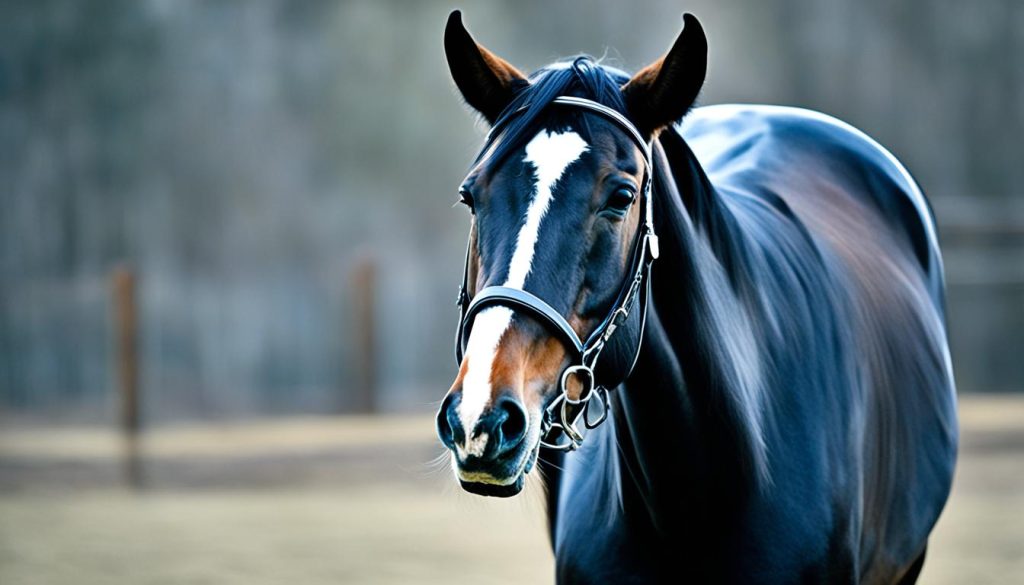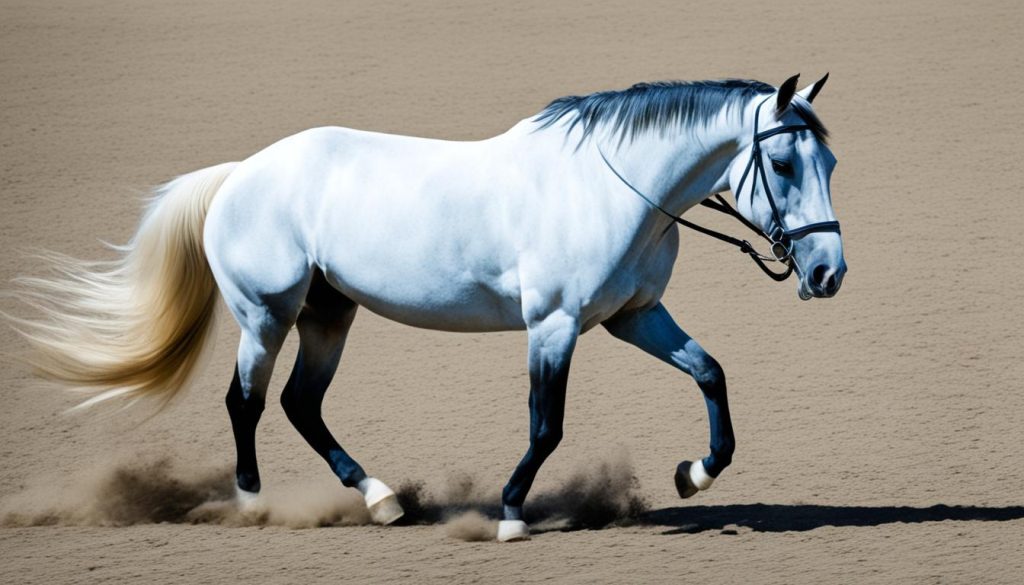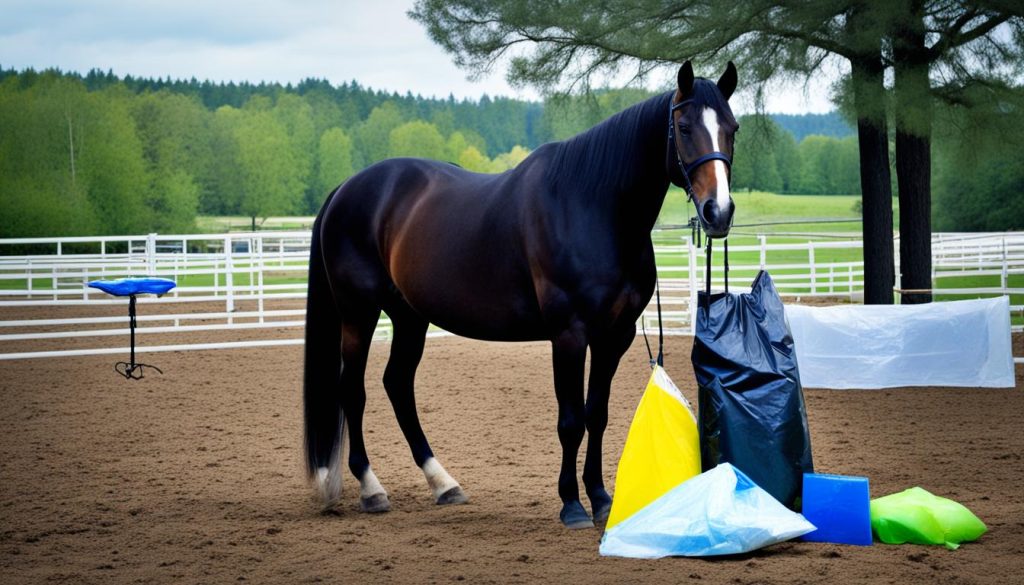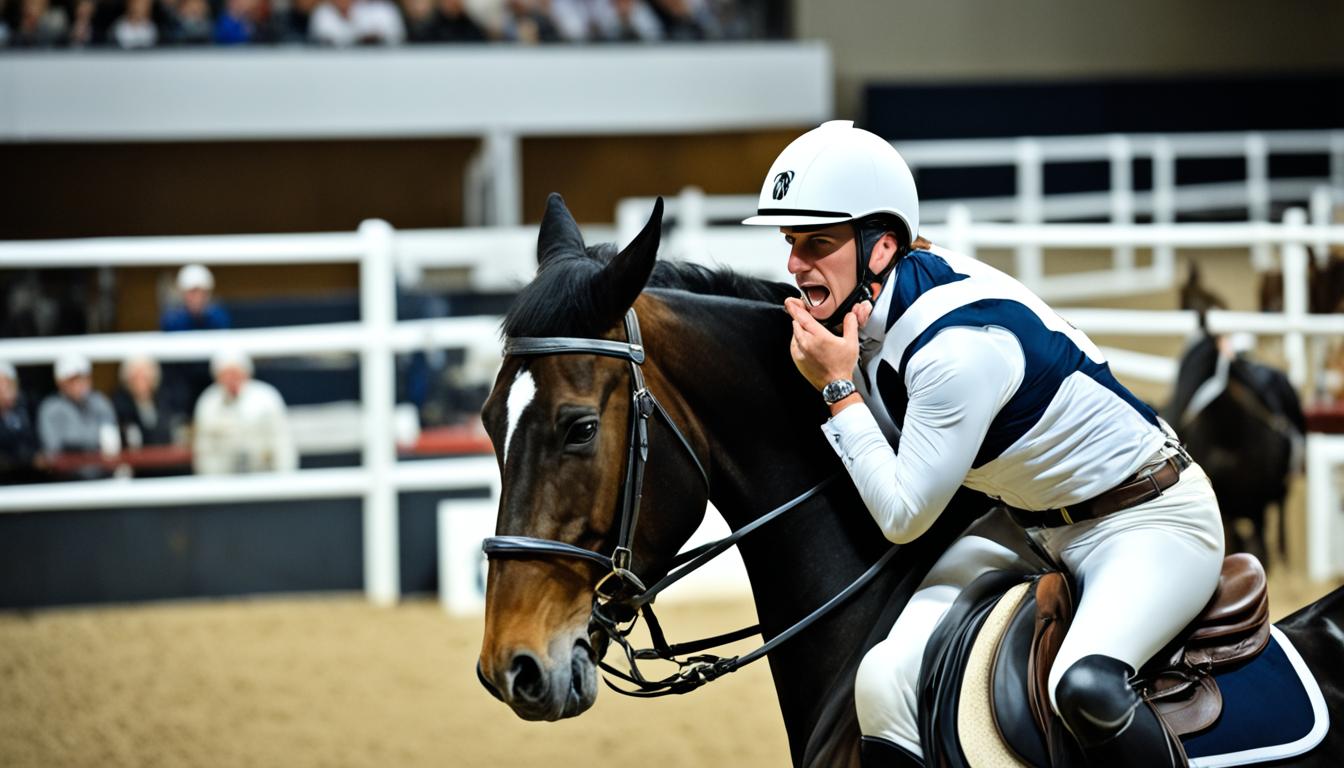Did you know that horse behavioral problems are a common challenge faced by many horse owners? From aggression and separation anxiety to bucking and biting, equine behavior issues can significantly impact your horse’s well-being and your partnership with them. But fret not, because in this comprehensive guide, we will provide you with effective solutions to address and resolve these behavioral problems using expert management and training techniques.
Understanding horse behavior is the first step towards creating a harmonious bond with your equine companion. Horses are highly social animals with complex communication systems and strong herd instincts. By delving into the intricacies of horse behavior, you can gain valuable insights into their motivations and develop strategies to modify their behavior.
In this guide, we will explore the most common horse behavioral problems, their root causes, and how to effectively manage and train your horse to overcome these challenges. From environmental management and stress reduction techniques to positive reinforcement training and behavior modification, we will equip you with the tools and knowledge you need to address and resolve equine behavioral issues. We will also share real-life case studies and success stories to inspire and guide you on your journey towards a fulfilling partnership with your horse.
Key Takeaways:
- Understanding horse behavior is crucial for addressing and resolving behavioral problems.
- Horses are social animals with intricate communication systems and strong herd instincts.
- Common horse behavioral problems include aggression, separation anxiety, and bucking.
- Behavior management techniques involve environmental control and stress reduction.
- Training methods such as positive reinforcement and behavior modification can effectively address equine behavior issues.
Understanding Horse Behavior
First and foremost, it is essential to understand the basics of horse behavior. Horses are social animals with intricate communication systems and strong herd instincts. By understanding how horses communicate and interact within their herd dynamics, you can gain valuable insights into their behavioral patterns and motivations.

Equine communication is a fascinating aspect of horse behavior. Horses communicate primarily through body language, using their ears, eyes, tail, and posture to convey messages to other horses and humans. Paying attention to how your horse expresses itself can help you develop a deeper bond and effectively respond to its needs.
Herd dynamics also play a crucial role in horse behavior. Horses are herd animals by nature, instinctively seeking safety, companionship, and a structured social order. Understanding the dynamics within a horse herd can help you establish a harmonious relationship with your own horse and create a sense of security.
It is important to note that while horses possess natural instincts, they are also intelligent and have the ability to learn and adapt to new environments and situations. By recognizing and respecting their natural instincts, you can provide an environment that promotes their well-being and supports their behavioral development.
Equine Communication
Horses communicate through a combination of vocalizations, body movements, and facial expressions. They use their ears to show their mood and attention, with forward-pointing ears indicating alertness and relaxation, and pinned-back ears conveying aggression or fear. Paying attention to these subtle cues can help you understand your horse’s emotional state and respond appropriately.
- Gesture: Horses use different body movements to express their intentions or communicate with other horses. For example, a lowered head combined with a relaxed stance can indicate submission, while an elevated head and tense posture may suggest alertness or aggression.
- Vocalizations: While horses are not as vocal as some other animals, they still use sounds like neighs, whinnies, and snorts to communicate with each other. These vocalizations can convey warning, invitation, or distress, depending on the context.
- Facial expressions: A horse’s facial expressions can reveal a lot about its emotional state. Wide open eyes may indicate excitement or fear, while a relaxed and soft expression suggests calmness and contentment.
Herd Dynamics
Herd dynamics are an integral part of a horse’s social behavior. In the wild, horses live in hierarchical groups, with a dominant stallion leading the herd and mares forming close-knit family units. Within the herd, horses establish their social positions through various interactions and displays of dominance or submission.
Understanding herd dynamics can help you establish yourself as a confident and trustworthy leader in your horse’s eyes. By mimicking the natural order of a herd, you can create a sense of stability and security for your horse, which can lead to better behavior and a stronger bond between you.
| Horse Behavior | Explanation |
|---|---|
| Aggression | Horse aggression can be caused by various factors, such as fear, dominance, or territoriality. Understanding the root cause can help address and manage aggressive behavior. |
| Fear and Anxiety | Horses can exhibit fearful or anxious behavior due to past traumas, new or unfamiliar situations, or perceived threats. Providing a calm and supportive environment can help alleviate these issues. |
| Separation Anxiety | Some horses may experience distress when separated from their herd mates or familiar surroundings. Gradual desensitization and positive reinforcement techniques can help reduce separation anxiety. |
Remember, every horse is unique, and their behavior is influenced by a variety of factors. By educating yourself about horse behavior, communication, and herd dynamics, you can develop a better understanding of your horse’s needs and create a partnership built on trust and respect.
Common Horse Behavioral Problems
Horse owners frequently encounter common behavioral problems such as aggression, separation anxiety, herd-bound behavior, bucking, rearing, biting, kicking, and barn sourness. These issues can arise due to a variety of factors, including fear, pain, training issues, or environmental stressors. It is important to identify the root causes of these problems to effectively address and resolve them.
The Impact of Horse Aggression
Horse aggression can pose a significant risk to both horses and their handlers. This aggressive behavior may manifest as biting, kicking, or charging. It is crucial to understand that horse aggression can stem from various causes, such as fear, dominance struggles, or pain.
Addressing Separation Anxiety
Separation anxiety occurs when horses become extremely distressed and anxious when separated from their herd or familiar companions. This behavior problem can lead to dangerous situations for both the horse and its handler. Providing appropriate socialization, gradual desensitization, and positive reinforcement training can help alleviate separation anxiety in horses.
Overcoming Herd-Bound Behavior
Herd-bound behavior, also known as buddy sourness, occurs when horses become overly attached to their herdmates, making it difficult to separate them. This can be a significant challenge during training or when horses need to be taken away from their herd for other purposes. Effective herd-bound behavior management involves establishing leadership, building trust, and gradually increasing separation distances.
Dealing with Bucking, Rearing, and Biting
Bucking, rearing, and biting are dangerous behaviors that can result in injuries to both the horse and rider. These behaviors can be triggered by pain, fear, or training issues. Identifying the underlying causes and implementing appropriate training techniques, such as positive reinforcement and systematic desensitization, can help address and modify these behaviors effectively.
Understanding Kicking and Barn Sourness
Kicking can present significant safety risks for both humans and other horses. It is essential to determine the reasons behind kicking behavior, which can include pain or frustration. Similarly, barn sourness, or herd-bound behavior specifically in relation to the barn, can make it challenging to lead horses away from the barn. Implementing consistent training and providing positive reinforcement can help manage and resolve these behaviors.
Understanding the underlying causes of common horse behavioral problems is the first step in addressing and managing them effectively. By implementing appropriate training techniques and addressing any root causes, horse owners can improve their equine partnerships and ensure the safety and well-being of both themselves and their horses.

| Behavior Problem | Main Causes | Management Techniques |
|---|---|---|
| Horse Aggression | Fear, dominance struggles, pain | Gradual desensitization, positive reinforcement training |
| Separation Anxiety | Fear of separation from herd or companions | Socialization, desensitization, positive reinforcement training |
| Herd-Bound Behavior | Over attachment to herd | Establishing leadership, trust-building, increasing separation distances |
| Bucking, Rearing, Biting | Pain, fear, training issues | Identifying underlying causes, positive reinforcement training, systematic desensitization |
| Kicking | Pain, frustration | Identifying causes, positive reinforcement training |
| Barn Sourness | Herdbound behavior specific to the barn | Consistent training, positive reinforcement |
Behavior Management Techniques
When it comes to addressing horse behavior problems, employing behavior management techniques is an effective approach. By implementing strategies that focus on environmental management, stress reduction, health management, positive reinforcement, desensitization, and systematic training, you can gradually modify your horse’s behavior and help them overcome their specific challenges.
One key aspect of behavior management is managing the horse’s environment. Providing a safe and comfortable space for your horse can contribute to their overall well-being and reduce negative behaviors. Ensure that their living quarters are clean, properly ventilated, and free from hazards. Offering ample turnout time for grazing and socializing with other horses can also promote a balanced mental state.
“A peaceful environment facilitates positive behavior and harmonious interaction among horses.”
In addition to environmental management, stress reduction techniques play a crucial role in behavior management. Horses, like humans, can experience stress that affects their behavior. Implementing stress reduction measures such as regular exercise, routine feeding schedules, and incorporating relaxation exercises into their daily routine can help alleviate stress and promote a calmer demeanor.
It is important to address any underlying health issues that may be contributing to your horse’s behavioral problems. Regular veterinary check-ups, proper nutrition, and appropriate supplementation are essential for maintaining your horse’s overall health. Consulting with a veterinarian or equine nutritionist can provide valuable insights and guidance for managing any health-related concerns.

Positive reinforcement is a powerful tool for behavior modification. By rewarding desired behaviors with treats, praise, or a gentle pat, you can strengthen the positive behaviors you wish to encourage in your horse. This approach builds trust and creates a positive association with desired actions, making them more likely to be repeated.
Desensitization is another valuable technique that helps horses overcome fears or anxieties. Gradually exposing your horse to potentially fearful stimuli in a controlled and positive manner can help them become more confident and less reactive. Working with a qualified trainer or behaviorist can provide guidance and ensure the desensitization process is done safely and effectively.
Systematic training is essential for addressing horse behavior problems. By breaking down complex skills or tasks into small, manageable steps, you can set your horse up for success. Each successful small step builds confidence and lays the foundation for more advanced training. Consistency, patience, and clear communication are key elements of systematic training.
By incorporating these behavior management techniques into your horse’s daily routine and training program, you can create a positive and productive environment for addressing behavioral problems. Remember, every horse is unique, and finding the right approach may require a trial-and-error process. Seek the guidance of experienced professionals and always prioritize your horse’s well-being.
Behavior Modification through Training
Behavior modification through training is a highly effective approach to address horse behavior problems. Different trainers utilize various techniques such as positive reinforcement training, negative reinforcement training, positive punishment training, negative punishment training, clicker training, and counter conditioning.
Positive reinforcement training is a widely respected and favorable technique in the equine world. By rewarding desired behaviors with treats or praise, horses learn to associate positive actions with positive outcomes. This training method focuses on building trust, cooperation, and a strong bond between horse and handler.
Negative reinforcement training, on the other hand, involves applying pressure or discomfort to motivate the horse to respond or comply. This approach relies on the release of pressure to reward the desired behavior, encouraging horses to make the desired choices to avoid discomfort or disturbance.
Positive punishment training, although less common, involves applying an aversive stimulus, such as a firm tap or a reprimand, to discourage unwanted behavior. It’s important to use positive punishment sparingly and in combination with positive reinforcement to ensure a balanced, fair, and respectful training experience.
Conversely, negative punishment training employs the removal of a desirable stimulus, such as briefly withholding treats or attention, to discourage undesirable behavior. This technique helps horses understand that certain actions result in the temporary loss of something pleasurable, encouraging them to avoid such behaviors in the future.
Clicker training and counter conditioning
Clicker training is a popular positive reinforcement technique where a “click” sound is used to mark desired behaviors, followed by a reward. This method helps horses associate the click with a reward, enabling precise communication and faster learning. Clicker training is especially effective for shaping complex behaviors and teaching new skills.
Counter conditioning is a valuable method used to change a horse’s emotional response to a specific stimulus. By gradually exposing the horse to situations or objects that trigger fear or anxiety and pairing them with positive experiences, such as treats or calming exercises, horses can learn to associate the previously aversive stimulus with positive outcomes. This approach helps horses overcome fear or stress-related behavior problems.
When training your horse, it’s crucial to prioritize positive reinforcement and clear communication. Building a trusting and respectful relationship with your horse lays the foundation for successful behavior modification. Remember, consistency, patience, and understanding are key to achieving positive results.
Case Studies and Success Stories
Real-life examples can provide valuable insights into effective problem-solving techniques and successful behavior modification when dealing with horse behavioral problems. By exploring these case studies and success stories, you can gain inspiration and learn from the experiences of other horse owners who have overcome similar challenges.
One inspiring story is that of Jane Thompson and her horse, Bella. Bella had a severe case of separation anxiety, which caused her to become extremely agitated and distressed whenever she was separated from the herd. Through consistent training and gradual desensitization exercises, Jane was able to help Bella overcome her separation anxiety and develop a calmer demeanor. Today, Bella confidently navigates various environments and can be safely separated from the herd without any signs of distress.
Another remarkable example is the success story of Mark Davis and his horse, Thunder. Thunder had a history of aggressive behavior, including biting and kicking. Mark implemented a systematic training approach that focused on positive reinforcement and clear communication. By rewarding Thunder for displaying calm and appropriate behaviors, Mark was able to modify Thunder’s aggressive tendencies and establish a trusting relationship based on mutual respect.
These real-life examples demonstrate the power of problem-solving and behavior modification techniques when applied with patience and consistency. They highlight the importance of understanding the underlying causes of behavioral problems and tailoring training methods to address specific issues.
When faced with horse behavior problems, it can be reassuring to know that others have successfully navigated similar challenges. By learning from these case studies, you can gain practical insights to apply to your own journey with your horse, fostering a strong partnership built on trust and successful behavior modification.
Remember, each horse is unique, and what works for one may not work for another. It’s essential to approach behavior modification with an open mind and a willingness to adjust your strategies as needed. With dedication and the right techniques, you can overcome even the most challenging horse behavioral issues and create a harmonious bond with your equine companion.
Conclusion
By understanding the intricacies of horse behavior and employing effective management and training techniques, you can cultivate a harmonious and fulfilling partnership with your equine companion. Resolving behavioral problems demands a holistic approach that takes into account the unique needs and instincts of your horse. Patience, consistency, and a deep comprehension of your horse’s behavior will enable you to overcome challenges and nurture a bond built on trust and mutual respect.
Insights into horse behavior provide invaluable guidance for successful equine partnership. By comprehending how horses communicate and function within their social hierarchies, you gain a deeper understanding of their motivations and behavioral patterns.
Addressing behavioral problems requires a comprehensive approach that considers both physical and psychological factors. By managing the horse’s environment, reducing stress levels, and addressing underlying health issues, you can create an optimal foundation for behavioral modification.
The techniques used to modify horse behavior involve positive reinforcement, clear communication, and consistent training. By focusing on rewarding desirable behaviors and employing effective training strategies, you can encourage your horse to overcome unwanted behaviors and display positive ones.
